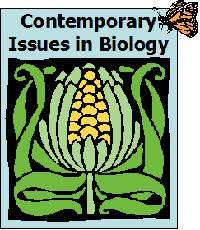
Week 9, Chapter 6 -- Digging Deeper
Course home | Weekly schedule | Announcements | Instructor Info | Desire2Learn | MasteringBiology® | Honor Code | FAQs | HELP!
 |
Week 9, Chapter 6 -- Digging DeeperCourse home | Weekly schedule | Announcements | Instructor Info | Desire2Learn | MasteringBiology® | Honor Code | FAQs | HELP! |
Part 1:
Visit this website devoted to cancer treatment "quackery": Cancer Treatment Watch: Your Guide to Intelligent Treatment. The website takes a decidedly skeptical view of a wide variety of alternative (non-mainstream) cancer treatments. The site covers a lot of ground, but in the links listed under "Cancer Quackery" heading is a link to “Index of Questionable Methods.” Click on it, then scroll down to find a long list of “Dubious Treatments.”
After you browse for a while, choose an "alternative cancer treatment" that interests you. It can be anything touted as a cancer treatment, as long as it is not a mainstream treatment like radiation or chemotherapy.
Once you have made your choice, enter the name of your treatment into Google (or another search engine) and find at least one site that describes specific scientific “proof” that the treatment works (often these sites promote the treatment or offer it for sale). As detailed below, your site(s) must describe one or more studies in enough detail that you can evaluate their scientific validity.
Part 2:
Write a brief report (450 words minimum) on the alternative treatment, including the following components:
Make sure you correctly cite all sources you consulted in writing your report. The sample assignment shows how to do this.
Remember, cutting and pasting from another website, without quotes or citation, is PLAGIARISM -- so is using a cut-and-pasted passage and just changing a few words. Plagiarism is a serious form of academic misconduct. If you have any questions about whether your work constitutes plagiarism, please visit the resources at week 1's plagiarism assignment, or ask your instructor.
Part 3:
Use D2L's spell checker (or the one on your word processor software, which will give you a word count as well). Proofread it yourself too, because spell checkers don't catch everything. When you are satisfied, post your completed assignment in the Digging Deeper forum for this week at the D2L discussion board.
Part 4:
Respond to at least two other students’ explanations. (If you are the first or second person to post, you will have to check back later to complete this part of the assignment). Your response should address whether you agree with the author's evaluation of the experiment and state your reasons for your opinion. It is not enough to say simply "nice job", "I liked that", "I think you're right about XXXX", "I disagree" etc. It is OK to disagree or agree, but the goal is to thoughtfully add something else interesting and new related to the content of the original post. At a minimum this should be at least 50 words, and 50-100 is preferable. Check out this page for more on the topic of good and bad responses.
After you have posted your assignment AND responded to two other students, go to Desire2Learn and complete the Gradebook Declaration for this week's Digging Deeper assignment. (Your Gradebook Declaration is subject to the Honor Code.)
Here is the text of the Desire2Learn Gradebook Declaration: (8 points) I have posted my spell-checked, proofread Digging Deeper assignment
at D2L. My assignment contains all the components listed in the assignment
instructions. |